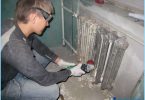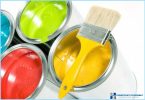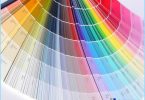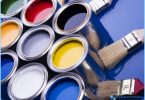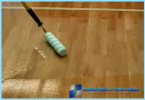The contents
- What you need to Prime the wall
- The benefits of priming
- The types and application
- Components
- Primer of deep penetration «Prospectors»
- The deep penetration primer Knauf tiefengrund
- Ceresit CT17 deep penetration
- Primer of deep penetration Eunice
- Primer deep penetration Optimist
- Primer of deep penetration Rusian
- A primer of deep penetration Bolars
- Application and consumption of the primer composition
What you need to Prime the walls ↑
Priming the walls is necessary in order to subsequently applied decorative coating could last for as long as possible. That is, the primer provides strong adhesion between the basic surface finishes and increases the duration of life and quality of the coating. Emulsion, penetrating into the subtle recesses and filling them, permeates the entire work surface.
The bulk emulsions available on the market of building materials, is a colloidal aqueous solution comprised of a polymer dispersion and various additives. After application to the surface of the primer emulsion fills the pores and cracks, dries, and polymer particles scruples with each other, form a continuous uniform film which allows vapour and air, while remaining waterproof.
The benefits of priming ↑
The clay structure does not take moisture from the freshly applied coating, giving it the ability to dry without cracking and peeling off. This is especially important in cases where the decorative coating will be applied on the surface with a strong absorption, e.g. aerated concrete, silicate bricks and so on.
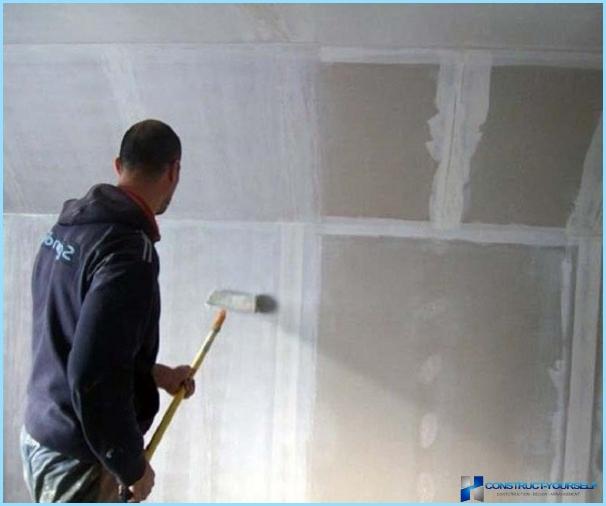
Plaster, putty and tile adhesive to better stick to progruntovali to the surface as the base becomes stickier. In addition, some types of primers in its composition have antifungal and antimicrobial additives that prevent the formation of mold.
The types and application ↑
There are several varieties of paint primer:
- front – anti-corrosion primer used to prevent rust on metal. For processing zinc is used a special composition;
- to prevent formation and growth of mould and fungi, it is recommended to use anti-fungal primer of deep penetration;
- to strengthen the surface applied impregnating composition. It is designed for the treatment of fragile coatings and drywall, but before laying ceramic tiles;
- to protect the treated surface from moisture use a special primer composition or paint, which are applied directly before finishing. These hydrophobic compounds can be purchased in stores of construction materials. It is worth noting that the primer composition is used for both internal and external works. The choice of emulsion depends directly on the quality and the workpiece material. In this case, the use of different facade primers, including acrylic and alkyd type;
- for finishing wood surfaces on the outside using a special antiseptic coating of deep penetration, which allows you to seal existing joints and sections. When painting wood experts recommend the use of alkyd-oil primer composition of the facade. This is because the oil is very elastic and has excellent penetrating ability.
Components ↑
Primer of deep penetration for the facade is a mixture of water and polymer resins. Facade primer emulsion has a deep permeability in a porous and friable materials, easily filling all the voids. After evaporation of the water composition begins to polimerservice.
Primer composition should be chosen based on the type of surface on which it will be applied. Before priming, and before painting, you must first clean the surface from dirt and dust, then dry.
Metal parts of the facade should be cleaned from rust. The clay composition or paint be applied by brush, roller or spray gun. Importantly, the applied layer is completely dry.
For priming concrete surfaces experts recommend the use of a special composition – applying mortar. This clay composition is used for treatment of thick substrates, which do not absorb moisture, before the plastering or puttying.
Part of applying mortar is a fine quartz sand, whereby high adhesion of finishing materials to smooth surfaces. Applying mortar used for interior and exterior use at temperatures below +5?C. If, for example, will need to perform the installation of ceiling tiles, on the white-washed surface, such treatment will greatly increase the chances that the material will hold fast.
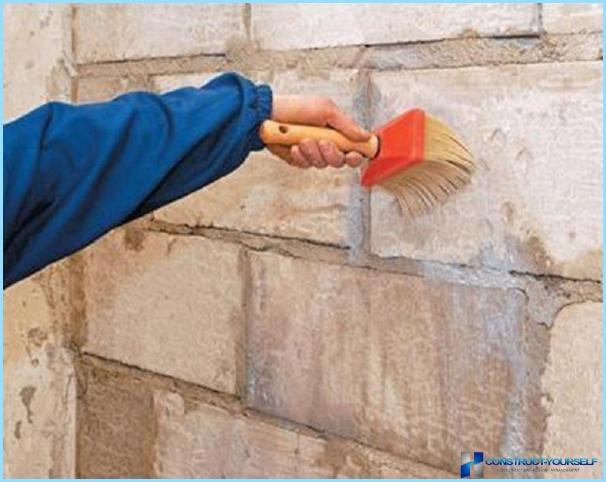
A universal primer composition suitable for surface treatment with high absorbency. Such surfaces include drywall, brick, cement screed, concrete, plaster and the like. Universal primer of deep penetration increases adhesion, reduces paint consumption, strengthens weak surfaces and prevents a backlog of Wallpaper from the walls.
After installation of the drywall sheets, prior to filling the surface must be progruntovali, especially in areas of cut. Consumption of primer is negligible, and the benefits are unquestionable, since the surface of the drywall to become more durable and interlock.
For priming to choose the tool is based on the type of surface. If you need to process large areas (ceiling, wall or floor), you can use masking Malik with medium pile and hard-to-reach places or corners, as a rule, use the brush up to 100 mm.
Primer of deep penetration «Prospectors» ↑
The smallest particles in the soil composition of the emulsion can penetrate the smallest pores of the surface that makes it easy to reinforce loose and weak walls. Suitable for processing of brick, wood, plaster, aerated concrete, concrete and gypsum. Depending on the absorbency of the treated surface, the depth of penetration of the soil may be 1-5 mm. Consumption primer of deep penetration «Prospectors» is 1l/5m?. The emulsion is packaged in containers of 5 and 10 l.
The deep penetration primer Knauf tiefengrund ↑
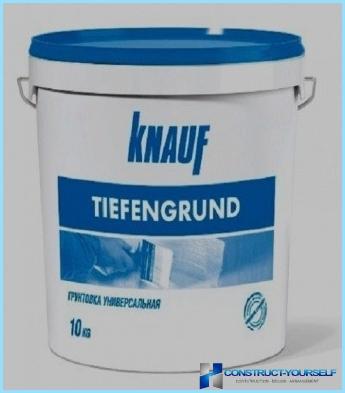
This ready-to-use colourless solution for treatment of walls under gluing Wallpaper, reason to the bathroom, masonry and to prepare for the flooring industry. The composition penetrates deeply into the surface, non-flammable, permeable to water vapour, binds dust. Consumption of a soil emulsion is 70-100 ml/m?. It is a universal primer of deep penetration, which is Packed in a container with a volume of 10 liters and can be used for interior and exterior.
Ceresit CT17 deep penetration ↑
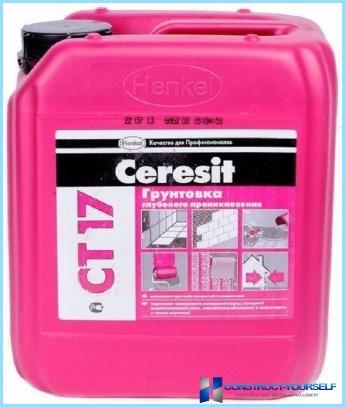
The priming emulsion is designed to increase the strength of the surface quality, adhesion and uniformly applied. Antifungal primer Ceresit CT17 used for the treatment of walls, bases of aerated concrete, gypsum plasters, concrete floors and so on. Available in containers of 10 litres and has a flow rate of 100-200 ml/m? in case of single application.
Primer of deep penetration Eunice ↑
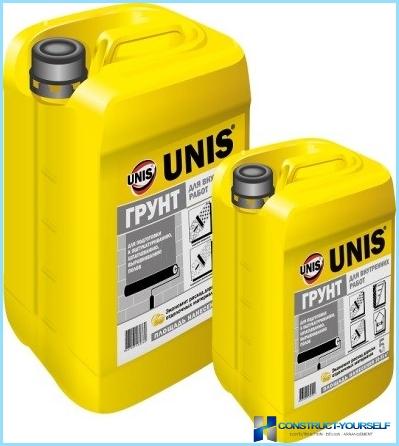
This brand of primer is preferred for working with the old, crumbling surfaces. Perfect for processing before filling with putty, plaster, tile adhesive, coating and flooring industry. Primer of deep penetration Eunice is designed to perform external and internal works and also for surface treatment in the absence of heating and in high humidity conditions. It often happens that this criterion is taken into account when buying a primer Eunice.
Primer deep penetration Optimist ↑
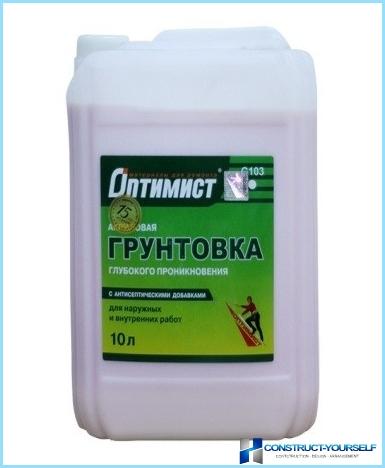
The primer mixture «Optimist» non-toxic, virtually odorless, flammable and explosive, and is an environmentally friendly material. In its composition the primer contains water, preservatives, acrylic and latex functional additives. Sold by primer packaged in 1-liter bottles and cans of 5 and 10 liters. The consumption of primer drying is about 250 ml/m?.
Primer of deep penetration Rusian ↑
Primer deep penetration Russian is an ecologically clean water dispersion of polymer with special additives and designed for the treatment of plastered surfaces, brick, concrete, aerated concrete and plaster bases. The primer has antiseptic properties that prevent the formation of mold and mildew. When the penetration depth of 1-5 mm, the emulsion flow rate is 100-200 ml/m?, depending on the absorbency of the substrate.
A primer of deep penetration Bolars ↑
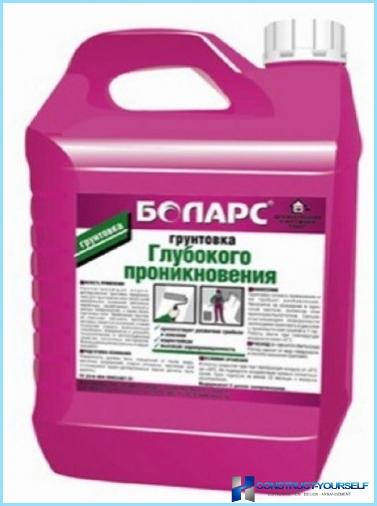
Primer made of acrylic, which allows to obtain high strength and durability of the coating, and reduce paint consumption. Primer Bolars regulates water absorption, increases adhesion and resistance to abrasion, allows walls to breathe. Applied to brick, concrete and aerated concrete surfaces and drywall. Can be used for both exterior and interior work. Primer consumption is 80ml/m?.
Application and consumption primer composition ↑
Facade primer or emulsion paint is applied after alignment of the working surface, which use a rough sandpaper. Primer must be applied evenly, and be sure to ensure that it does not hit in the eye. After work should wash and clean the tool. The remains of the primer, only if it does not concentrate, can drain back into the container.
For more of the effect of primer composition is applied in two or more layers. Drying usually lasts for 1-4 hours, while the ambient temperature must be below +20?C.
Consumption of certain types of soil is:
- emulsion deep penetration – 100 ml/m?;
- applying mortar – 350 ml/m?;
- decorative primer – 200 ml/m?;
- special formulations for wall – 50-100 ml/m?.
In principle, the consumption of primer depends on the surface material, its characteristics and the producer of the mixture. In addition to the packaging of ground structures necessarily identifies all the main characteristics, flow, drying time and so on.
Please look at the video briefly explains what priming is and why it is needed.


